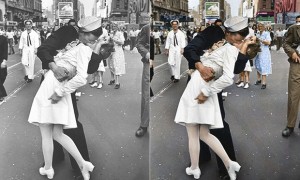In today’s Wall Street Journal “Sightings” column, I consider the vogue of colorized historical photographs. Here’s an excerpt.
* * *
Once upon a time—a quarter-century ago, to be exact—colorization became a dirty word almost overnight. Ted Turner had been marketing watery-looking “color” versions of popular black-and-white movies, an enterprise that Gene Siskel and Roger Ebert labeled “Hollywood’s new vandalism.” Ginger Rogers agreed, declaring that it “feels terrible…to see yourself painted up like a birthday cake on the television screen.” Then, in 1989, Mr. Turner announced plans to colorize “Citizen Kane,” Orson Welles’ masterpiece, and Hollywood’s patience ran out. Leading directors like John Huston and Martin Scorsese declared their opposition to colorization, and before long, Turner Entertainment abandoned the practice.
To this day, the marketing of colorized prints of “Kane” and other classic films of the past is still widely regarded as unacceptable, even unthinkable. Historical photographs, on the other hand, have come to be seen as fair game. Now that digital technology has advanced to the point where it is possible to add convincing-looking color to photos of the 19th and early 20th centuries, the Internet is awash in electronically tinted portraits of everybody from Anne Frank to Abraham Lincoln….
 In the hands of a sensitive, historically knowledgeable artist like Sweden’s Sanna Dullaway, digital colorization can be not merely plausible but positively seductive. To look at Ms. Dullaway’s full-color versions of such familiar photos as Alfred Eisenstaedt’s “V-J Day in Times Square” side by side with the originals is to appreciate the credo that appears on her website: “No colorized photo can replace the original black-and-white picture, but each will give you a new perspective on how your grandparents and great-grandparents used to see the world. Rather than living in the misty grey world we usually see, the sun shone just as bright, if not more brightly, on them.”
In the hands of a sensitive, historically knowledgeable artist like Sweden’s Sanna Dullaway, digital colorization can be not merely plausible but positively seductive. To look at Ms. Dullaway’s full-color versions of such familiar photos as Alfred Eisenstaedt’s “V-J Day in Times Square” side by side with the originals is to appreciate the credo that appears on her website: “No colorized photo can replace the original black-and-white picture, but each will give you a new perspective on how your grandparents and great-grandparents used to see the world. Rather than living in the misty grey world we usually see, the sun shone just as bright, if not more brightly, on them.”
That said, Ms. Dullaway’s colorized photos, as she hastens to admit, are not the real thing. They are, rather, immensely sophisticated recreations—falsifications, if you like—of the past. This was brought home to me when I noticed that colorized historical photographs by Ms. Dullaway and other retouchers were starting to circulate on the web via Twitter. Some are clearly labeled, but most are not, and my guess is that most people, seeing these images for the first time, take it for granted that they are not digital recreations but original color photos.
Does that matter? Or is it old-fogeyism to grumble about a technology that really does bring history to more obviously vivid life? I confess to being both attracted and alarmed by the communicative power of these photos….
* * *
Read the whole thing here.
